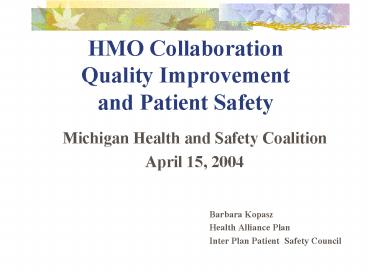HMO Collaboration Quality Improvement and Patient Safety - PowerPoint PPT Presentation
1 / 17
Title:
HMO Collaboration Quality Improvement and Patient Safety
Description:
Monitor hospital compliance with JCAHO National Patient Safety Goals. Support hospital quality and safety improvements beyond Leapfrog and JCAHO ... – PowerPoint PPT presentation
Number of Views:48
Avg rating:3.0/5.0
Title: HMO Collaboration Quality Improvement and Patient Safety
1
HMO CollaborationQuality Improvementand Patient
Safety
- Michigan Health and Safety Coalition
- April 15, 2004
- Barbara Kopasz
- Health Alliance Plan
- Inter Plan Patient Safety Council
2
Employer Health Care Concerns
- Cost
- Double digit rate increases
- Health care as growing percentage of total labor
cost - Hospital rate increases, drugs and new technology
costs driving trends - Quality
- Inefficiencies/errors in care delivery
- Patient Safety Concerns
- Poor coordination of care for people with chronic
conditions aging population - Limited Best Practice sharing/measurement
3
Employer Health Care Concerns
- Utilization
- Waste in the healthcare delivery system
- Inappropriate use (misuse, overuse and underuse)
of health care services - Wide variation in practice patterns between
communities
4
Health Plan Role
Consumer
Purchaser
Expect to Meet Needs
Hold Accountable
Health Plan
- Provide Quality Leadership
- Hold Delivery System Accountable for Value
- Provide Delivery System With
- - Information - Coordination
- - Support - Communication
- Selection and Contracting
Delivery System
Primary Care Physician
Hospital
Pharmacy
Specialty Physician
Home Health Care
Behavioral Health
Diagnostic Services
Other Therapeutic Services
Centers of Excellence
5
Employer Framework
- Look at the data cost, quality, utilization,
performance indicators - RFIs
- HEDIS?
- Measure the performance of health plan and
providers - Share performance information with consumers
- Reward high-quality performance and penalize
poor-quality performance
6
Health Plan Challenges
- Employer Specific Initiatives
- RFIs
- Provide comparative data to purchasers
- Plan Administration
- Health Promotion
- Chronic Disease Management
- HEDIS
- Pharmacy Management
- Patient Safety
- Customer Satisfaction
- Community Initiatives
7
Driving collaboration and change in Michigan
- Tobacco cessation benefit design
- Interplan Patient Safety Workgroup
- MI Health Safety Coalition, collaborative
implementation of safety standards, common
messages for members - Interplan Behavioral Health Workgroup
- development of depression and substance abuse
guidelines, common patient release form - Individual plan experiences
- MQIC
8
History of Health Plan Collaboration
- History of working together to address common
issues regarding the eValue8 RFI formerly GDAHC - Creating the Inter-Plan Patient Safety natural
evolution - RFI challenges
- Employer accountability
- Many health plans worked with GM Top 11
initiatives - MQIC
9
Purchasers Expectations
- Foster an approach to patient safety
- Emphasis on systemic improvements
- Reward superior efforts to reduce errors
- Fulfill Leapfrog purchasing principles
- Educate and inform enrollees
- Highlight Leapfrog recommended patient safety
practices - Reward superior provider value
10
Purchasers Expectations
- Determine the rate at which members were at risk
for preventable medical mistakes during a recent
hospitalization due to the absence of one or more
of the Leapfrog recommended patient safety
practices. - Calculate the admissions going to hospitals that
have implemented one or more of the standards
relevant to the condition and have a strategy to
increase the rate - Recognize and reward hospitals and encourage
member admissions to compliant hospitals
11
Patient SafetyMichigan Inter-Plan Patient
Safety Council
- RFI Expectations
- Written Patient Safety Strategic Plan
- Activities to inform contracted hospitals,
practitioners and members about Leapfrog
standards and reporting requirements - Activities to develop and disseminate information
on what members can do to reduce the chance they
will be subject to preventable medical errors - Activities to monitor use of hospitals that meet
Leapfrog standards - Activities to increase the percentage of members
admitted to hospitals that meet the Leapfrog
standards.
12
RFI Expectations
- Develop and provide educational materials to
- Health Plan contracted hospitals
- Health Plan contracted practitioners
- Health Plan members
- Ability to rank hospitals based on survey scores
- Make data available to providers and members
- Develop hospital report cards
- Encourage members to seek services at hospitals
that meet the Leapfrog standards
13
Patient Safety Expectations
- Monitor hospital compliance with JCAHO National
Patient Safety Goals - Support hospital quality and safety improvements
beyond Leapfrog and JCAHO - Support hospital performance on the National
Quality Forum measures - Encourage rural hospital participation in the
survey
14
Patient Safety Future Activities
- SEM Health Plans will continue to collaborate on
common issues to reduce burden to hospitals - SEM Health Plans will continue to work with MHA
on identifying common patient safety initiatives - E.g. stroke program
- Other initiatives being discussed
- Further collaboration on development of member
education materials - Pharmacy workgroup coordination
- Rural hospital outreach
- Continue to identify efficiencies to reduce
hospital burden re data collection - Create inventory of hospital patient safety
initiatives
15
Inter-Plan Patient Safety Council
- Health Plan Participants
- Blue Care Network
- Care Choices
- HAP
- Health Plus
- MCare
- Paramount
- Priority Health
16
Summary
- Poor quality is costly and is a problem facing
all of us - Failure to consider quality when purchasing
healthcare IS part of the problem - Employers believe the way to reduce health care
cost is to improve qualityand provide people
with the information on quality to make smart
health care decisions - Going forward we will continue to attack the
epidemic of medical mistakes with better systems,
accountability, more training and education and
exchanging knowledge to advantage one another
17
- Together we can assemble a system that is
stronger and more reliable than the sum of its
parts not perfect but much better. - Source Internal Bleeding
- Robert M. Wachter, M.D. and Kaveh G. Shojania,
M.D.































